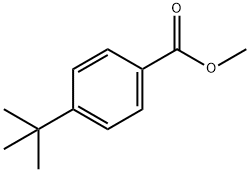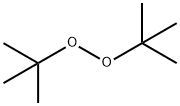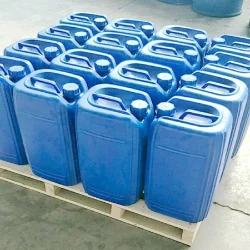tert-Butyl hydroperoxide
Synonym(s):1,1-Dimethylethyl hydroperoxide;2-Hydroperoxy-2-methylpropane;TBHP
- CAS NO.:75-91-2
- Empirical Formula: C4H10O2
- Molecular Weight: 90.12
- MDL number: MFCD00002130
- EINECS: 200-915-7
- SAFETY DATA SHEET (SDS)
- Update Date: 2025-09-25 17:15:13

What is tert-Butyl hydroperoxide?
Description
tert-Butyl hydroperoxide (TBHP) is an organic peroxide widely used in a variety of oxidation processes.
Chemical properties
tert-Butyl hydroperoxide (TBHP) is a water-white liquid commonly commercially available as a 70% solution in water; 80% solutions are also available. It is used to initiate polymerization reactions and in organic syntheses to introduce peroxy groups into the molecule. TBHP vapor can burn in the absence of air and may be flammable at either elevated temperature or at reduced pressure. Fine mist/spray may be combustible at temperatures below the normal flash point. When evaporated, the residual liquid will concentrate TBHP content and may reach an explosive concentration (>90%). Closed containers may generate internal pressure through the degradation of TBHP to oxygen . TBHP is a highly reactive product. The three types of significant physical hazards are flammability, thermal, and decomposition due to contamination. To minimize these hazards, avoid exposure to heat, fire, or any condition that will concentrate the liquid material. Store away from heat, sparks, open flames, foreign contaminants, combustibles, and reducing agents. Inspect containers frequently to identify bulges or leaks (7a, 125).
The Uses of tert-Butyl hydroperoxide
tert-Butyl hydroperoxide is used as an initiator for radical polymerization and in various oxidation process such as sharpless epoxidation. It is involved in osmium catalyzed vicinal hydroxylation of olefins under alkaline conditions. Furthermore, it is used in catalytic asymmetric oxidation of sulfides to sulfoxides using binaphthol as a chiral auxiliary and in the oxidation of dibenzothiophenes. It plays an important role for the introduction of peroxy groups in organic synthesis.
The Uses of tert-Butyl hydroperoxide
TBHP is an intermediate in the production of propylene oxide and t-butyl alcohol from isobutane and propylene. It is primarily used as an initiator and finishing catalyst in the solution and emulsion polymerization methods for polystyrene and polyacrylates. Other uses are for the polymerization of vinyl chloride and vinyl acetate and as an oxidation and sulfonation catalyst in bleaching and deodorizing operations. It is a strong oxidant and reacts violently with combustible and reducing materials, and metallic and sulfur compounds.
Definition
ChEBI: Tert-butyl hydroperoxide is an alkyl hydroperoxide in which the alkyl group is tert-butyl. It is widely used in a variety of oxidation processes. It has a role as an antibacterial agent and an oxidising agent.
Production Methods
TBHP is produced by the liquid-phase reaction of isobutane and molecular oxygen or by mixing equimolar amounts of t-butyl alcohol and 30–50% hydrogen peroxide. TBHP can also be prepared from t-butyl alcohol and 30% hydrogen peroxide in the presence of sulfuric acid or by oxidation of tert-butylmagnesium chloride. The manufacturing process of TBHP is in a closed system.
General Description
Watery odorless colorless liquid. Floats and mixes slowly with water.
Air & Water Reactions
Water soluble.
Reactivity Profile
Most alkyl monohydroperoxides are liquid. The explosivity of the lower members (e.g., methyl hydroperoxide, or possibly, traces of the dialkyl peroxides) decreasing with increasing chain length and branching [Bretherick 2nd ed. 1979 p. 10]. Though relatively stable, explosions have been caused by distillation to dryness [Milas, JACS 1946, 68, 205] or attempted distillation at atmospheric pressure [Castrantas 1965 p. 15].
Hazard
Moderate fire risk. Oxidizer.
Health Hazard
tert-Butyl hydroperoxide is a strong irritant.Floyd and Stockinger (1958) observed thatdirect cutaneous application in rats did notcause immediate discomfort, but the delayedaction was severe. The symptoms were erythemaand edema within 2–3 days. Exposureto 500 mg in 24 hours produced asevere effect on rabbit skin, while a rinse of150 mg/min was severe to eyes.
It is moderately toxic; the effects aresomewhat similar to those of MEK peroxide.Symptoms from oral administration in ratswere weakness, shivering, and prostration.
LD50 value, intraperitoneal (rats): 87 mg/kg
LD50 value, oral (rats): 406 mg/kg.
Flammability and Explosibility
tert-Butyl hydroperoxide is a flammable liquid and a highly reactive oxidizing agent. Pure TBHP is shock sensitive and may explode on heating. Carbon dioxide or dry chemical extinguishers should be used for fires involving tert-butyl hydroperoxide.
Mechanism of action
The general mechanism of transition metal-catalyzed oxidative Mannich reactions of N, N-dialkyl anilines with tert-butyl hydroperoxide (TBHP) as the oxidant consists of a rate-determining single electron transfer (SET) that is uniform from 4-methoxy- to 4-cyano-N, N-dimethylanilines. The tert-butylperoxy radical is the major oxidant in the rate-determining SET step that is followed by competing backward SET and irreversible heterolytic cleavage of the carbon–hydrogen bond at the α-position to nitrogen. A second SET completes the conversion of N, N-dimethylaniline to an iminium ion that is subsequently trapped by the nucleophilic solvent or the oxidant prior to the formation of the Mannich adduct[1].
Tert-butyl hydroperoxide could induce oxidative stress in liver mitochondria at low concentrations. The damaging effect of low concentrations of tBHP in the course of pyruvate oxidation in isolated liver mitochondria is caused by the opening of the nonspecific Ca2+-dependent cyclosporin A-sensitive pore in the inner mitochondrial membrane[2].
Safety Profile
Moderately toxic by ingestion and inhalation. A severe skin and eye irritant. Mutation data reported. At highest dosage levels, symptoms noted were severe depression, incoordmation, and cyanosis. Death was due to respiratory arrest. Very dangerous fire hazard when exposed to heat or flame, or by spontaneous chemical reaction such as with reducing materials. Moderately explosive; may explode during distillation. Violent reaction with traces of acid. Concentrated solutions may ignite spontaneously on contact with molecular sieve. Mixtures with transition metal salts may react vigorously and release oxygen. Forms an unstable solution with 1,2-dichloroethane. To fight fire, use alcohol foam, CO2, dry chemical. When heated to decomposition it emits acrid smoke and fumes. See also PEROXIDES, ORGANIC.
Carcinogenicity
A study performed to evaluate the carcinogenicity of TBHP found it was not carcinogenic when applied to the skin of mice at 16.6% of the peroxide 6 times a week for 45 weeks. However, if its application was preceded by 0.05 mg of 4-nitroquinoline-1-oxide as a 0.25% solution in benzene applied 20 times over 7 weeks followed by TBHP (16.6% in benzene), then malignant skin tumors appeared between days 390 and 405 of the experiment . This supports the theory that peroxides are not complete carcinogens, but may act as promoters . The effects of TBHP on promotable and nonpromotable mouse epidermal cell culture lines were reported by Muehlematter et al. .
Storage
tert-butyl hydroperoxide should be stored in the dark at room temperature (do not refrigerate) separately from oxidizable compounds, flammable substances, and acids. Reactions involving this substance should be carried out behind a safety shield.
Toxicity evaluation
TBHP accelerates oxidation of glutathione and decreases the metabolism of sodium hexobarbital in rat livers and is a strong oxidation agent.
Incompatibilities
tert-Butyl hydroperoxide and concentrated aqueous solutions of TBHP react violently with traces of acid and the salts of certain metals, including, in particular, manganese, iron, and cobalt. Mixing anhydrous tert-butyl hydroperoxide with organic and readily oxidized substances can cause ignition and explosion. TBHP can initiate polymerization of certain olefins.
Waste Disposal
Excess tert-butyl hydroperoxide and waste material containing this substance should be placed in an appropriate container, clearly labeled, and handled according to your institution's waste disposal guidelines.
References
[1] Maxim O, et al. Mechanistic Investigation of Oxidative Mannich Reaction with tert-Butyl Hydroperoxide. The Role of Transition Metal Salt. Journal of the American Chemical Society, 2013; 135: 1549–1557.
[2] Fedotcheva N, et al. Mechanism of induction of oxidative stress in liver mitochondria by low concentrations of tert-butyl hydroperoxide. Biochemistry (Moscow), 2013; 78: 75–79.
Properties of tert-Butyl hydroperoxide
| Melting point: | -2.8 °C |
| Boiling point: | 37 °C (15 mmHg) |
| Density | 0.937 g/mL at 20 °C |
| vapor pressure | 62 mmHg at 45 °C |
| refractive index | n |
| Flash point: | 85 °F |
| storage temp. | 2-8°C |
| form | Liquid |
| pka | pK1: 12.80 (25°C) |
| color | Clear colorless |
| Water Solubility | Miscible |
| Merck | 14,1570 |
| BRN | 1098280 |
| Exposure limits | No exposure limit is set. On the basis
of its irritant properties a ceiling limit of
1.2 mg/m3 (0.3 ppm) is recommended. |
| Stability: | Stable, but may explode if heated under confinement. Decomposition may be accelerated by traces of metals, molecular sieve or other contaminants. Incompatible with reducing agents, combustible material, acids. |
| CAS DataBase Reference | 75-91-2(CAS DataBase Reference) |
| NIST Chemistry Reference | Tert-butyl hydroperoxide(75-91-2) |
| EPA Substance Registry System | tert-Butyl hydroperoxide (75-91-2) |
Safety information for tert-Butyl hydroperoxide
| Signal word | Danger |
| Pictogram(s) |
 Flame Flammables GHS02  Corrosion Corrosives GHS05  Skull and Crossbones Acute Toxicity GHS06  Exclamation Mark Irritant GHS07  Health Hazard GHS08  Environment GHS09 |
| GHS Hazard Statements |
H226:Flammable liquids H242:Self-reactive substances and mixtures; and Organic peroxides H300:Acute toxicity,oral H302:Acute toxicity,oral H304:Aspiration hazard H310:Acute toxicity,dermal H311:Acute toxicity,dermal H314:Skin corrosion/irritation H317:Sensitisation, Skin H318:Serious eye damage/eye irritation H330:Acute toxicity,inhalation H336:Specific target organ toxicity,single exposure; Narcotic effects H341:Germ cell mutagenicity H371:Specific target organ toxicity, single exposure H372:Specific target organ toxicity, repeated exposure H373:Specific target organ toxicity, repeated exposure H410:Hazardous to the aquatic environment, long-term hazard H411:Hazardous to the aquatic environment, long-term hazard |
| Precautionary Statement Codes |
P201:Obtain special instructions before use. P202:Do not handle until all safety precautions have been read and understood. P210:Keep away from heat/sparks/open flames/hot surfaces. — No smoking. P220:Keep/Store away from clothing/…/combustible materials. P233:Keep container tightly closed. P234:Keep only in original container. P240:Ground/bond container and receiving equipment. P260:Do not breathe dust/fume/gas/mist/vapours/spray. P261:Avoid breathing dust/fume/gas/mist/vapours/spray. P264:Wash hands thoroughly after handling. P264:Wash skin thouroughly after handling. P270:Do not eat, drink or smoke when using this product. P271:Use only outdoors or in a well-ventilated area. P272:Contaminated work clothing should not be allowed out of the workplace. P273:Avoid release to the environment. P280:Wear protective gloves/protective clothing/eye protection/face protection. P284:Wear respiratory protection. P310:Immediately call a POISON CENTER or doctor/physician. P320:Specific treatment is urgent (see … on this label). P331:Do NOT induce vomiting. P301+P310:IF SWALLOWED: Immediately call a POISON CENTER or doctor/physician. P303+P361+P353:IF ON SKIN (or hair): Remove/Take off Immediately all contaminated clothing. Rinse SKIN with water/shower. P304+P340:IF INHALED: Remove victim to fresh air and Keep at rest in a position comfortable for breathing. P305+P351+P338:IF IN EYES: Rinse cautiously with water for several minutes. Remove contact lenses, if present and easy to do. Continuerinsing. P405:Store locked up. P410:Protect from sunlight. P403+P233:Store in a well-ventilated place. Keep container tightly closed. |
Computed Descriptors for tert-Butyl hydroperoxide
| InChIKey | CIHOLLKRGTVIJN-UHFFFAOYSA-N |
tert-Butyl hydroperoxide manufacturer
ASM Organics
New Products
4,4-Difluoropiperidine hydrochloride tert-butyl 9-methoxy-3-azaspiro[5.5]undecane-3-carboxylate Indole Methyl Resin N-Isopropylurea N,N-Dicyclohexylcarbodiimide(DCC) MELDRUMS ACID 5-METHYLISOXAZOLE-4-CARBOXYLIC ACID Magnessium Bis glycinate Zinc ascorbate 1-bromo-2-butyne 2-acetamidophenol 9(10H)-anthracenone Erythrosin B, 4-Piperidinopiperidine 2-((4-morpholinophenylamino) (methylthio) methylene) malononitrile 2,4-dihydroxybenzaldehyde 3-(4-morpholinophenylamino)-5-amino-1H-pyrazole-4-carbonitrile Methyl 2-methylquinoline-6-carboxylate 2,6-dichloro-4-nitropyridine 4-Bromo-2-chlorobenzonitrile 2-(benzylamino)acetic acid hydrochloride 4-(tert-Butoxycarbonylamino)but- 2-ynoic acid 3,4-dihydro-2H-benzo[b][1,4]dioxepine 1-Phenyl-1-cycloprppanecarboxylicacidRelated products of tetrahydrofuran








You may like
-
 75-91-2 Tert-Butyl hydroperoxide 99%View Details
75-91-2 Tert-Butyl hydroperoxide 99%View Details
75-91-2 -
 75-91-2 99%View Details
75-91-2 99%View Details
75-91-2 -
 tert-butyl hydroperoxide CASView Details
tert-butyl hydroperoxide CASView Details -
 tert-Butyl hydroperoxide CASView Details
tert-Butyl hydroperoxide CASView Details -
 Tert-Butylhydroperoxide CAS: 75-91-2View Details
Tert-Butylhydroperoxide CAS: 75-91-2View Details
75-91-2 -
 Tert Butyl Hydro Peroxide (TBHP)View Details
Tert Butyl Hydro Peroxide (TBHP)View Details
75-91-2 -
 Tert-Butyl Hydroperoxide LiquidView Details
Tert-Butyl Hydroperoxide LiquidView Details
75-91-2 -
 tert-Butyl hydroperoxide CAS No.:75-91-2View Details
tert-Butyl hydroperoxide CAS No.:75-91-2View Details
75-91-2
